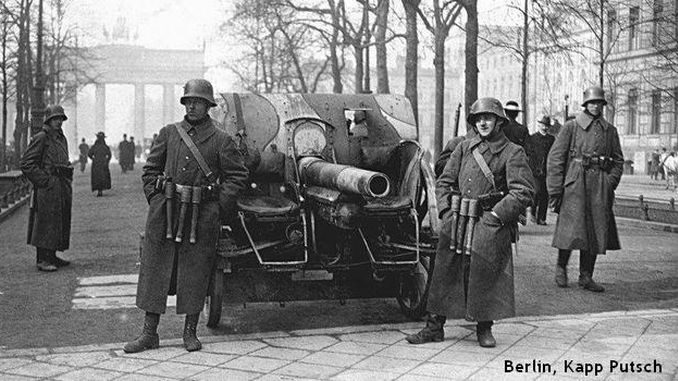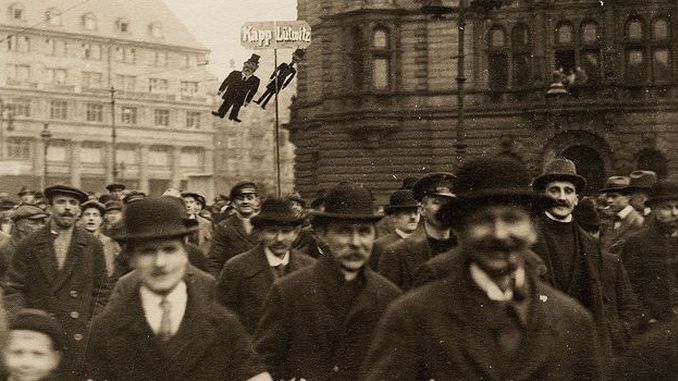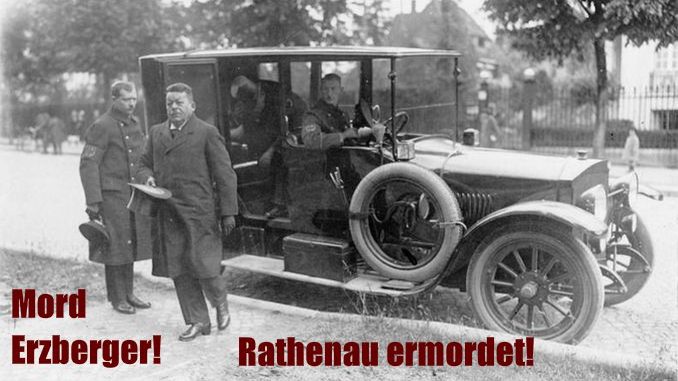
This chapter if about the first German republic, named after the city of Weimar where the national assembly met in 1919, to decide about a constitution and to form a new government. However, the young Weimar Republican had to struggle from its start.
Years of crisis
Germany, 1918/1919. After the defeat in the World War I, Germany was in disastrous shape. The war had ended, but the country was not in peace. Friedrich Ebert (SPD) had taken over government, but he could not win the old elites for the new, democratic regime. What would Germany’s future be like?
After the bloody January uprising in Berlin and the murders of Rosa Luxemburg Liebknecht, political enmity had become hatred. In Berlin, Saxony, the Rhineland, and the Ruhr area general strikes and heavy fighting made the first years of the Weimar Republic almost civil-war-like.
The National Assembly in Weimar
In the elections for the National Assembly on January 19, 1919, women could vote for the first time. The SPD emerged as the strongest faction and built a coalition with the Center Party / Bavarian People’s Party and the German Democratic Party, the so-called “Weimar Coalition” of 1919.
On February 6, 1919, the National Assembly met in Weimar, and this venue has given the first German Republic its name. Friedrich Ebert (SPD) became the first Reichspräsident on February 11. Two days later, the Provisional Government assigned its authority to the first democratic government under Chancellor Philipp Scheidemann.
The constitution came into force on 11 August. It was one of the freest in the world, as it enshrined fundamental rights and did not contain any extremist decree or party bans. But it also gave its sworn enemies all rights and opportunities. The Reichspräsident was directly elected by the people and had a forceful position. He appointed and dismissed the Chancellor and his Government, he could dissolve the Reichstag, and he had the supreme command of the armed forces, the Reichswehr. Moreover, article 49 enabled him to issue emergency decrees.
The Treaty of Versailles
While the National Assembly in Weimar debated, the victorious powers negotiated in Paris. US President Woodrow Wilson could not push through his “Fourteen Points”. The conditions for peace were very hard.
Germany had to accept responsibility for the losses and damages caused by the war. She had to pay large-scale reparations, drastically reduce her troops and hand over most of her war material. In addition, she lost large territories and all colonies. The left and right banks of the Rhine would be permanently demilitarized. Allied troops would occupy the left bank of the Rhine and bridge heads in Cologne for a period of 5-15 years. Moreover, the Allies had to right to occupy the right bank, too, if they found that Germany violated the treaty.
The harsh conditions were a shock to everyone who had hoped for a milder peace based on Wilson’s Fourteen Points. The Scheidemann administration resigned. But there was no other way, on June 28, Germany signed the Treaty of Versailles.

Kapp-Putsch
According to the Treaty of Versailles, the Reichswehr had to demobilize her troops early in 1920, and that meant the dissolution of all Free Corps. It caused great embitterment among them since they had fought for the new government.
The extreme right-wing politician Wolfgang Kapp made use of that situation. On March 13, he led the rebelling Freikorps’ march on Berlin and proclaimed himself Chancellor (Kapp-Putsch). In the Empire, that would have been high treason, yet now the Reichswehr officers would not give orders to fire at fellow Reichswehr troops. Nonetheless, the putsch collapsed after four days because the civil servants in Berlin refused to take orders from Kapp, and all over the country general strikes occurred.
Red Ruhr Army
In the Ruhr Area, civil unrest and general strikes again the Kapp putsch grew into civil war. The same day, a “Red Ruhr Army” of 50,000 men formed. Supported by a strike of more than 300,000 miners, they conquered the whole area. In vain Minister of Interior Severing, a brave democrat, struggled for a non-violent settlement. Eventually, Reichswehr troops and Free Corps crushed the uprising, shooting even wounded persons according to martial law until Reichspräsident Ebert stopped it. These traumatic experiences left their marks. In the first regular elections in June 1920, the “Weimar Coalition” lost its majority. In the following years, many short-lived administrations followed.
132 Milliards Goldmark reparations payments
In May 1921, the reparation payments were determined to be 132 milliards, to be paid in 37 years. Yet, all administrations in those years had no choice, they had to fulfill the demands and could only hope that it would soon turn out that Germany could not afford these astronomically high reparations payments. In that situation, Chancellor Wirth and Foreign Minister Walter Rathenau concluded in April 1922 the Treaty of Rapallo with the Soviet Union: Both countries renounced war claims, made trade agreements and established diplomatic relations. By that, the young Weimar Republic had taken a bit of pressure of itself, but the Allies were suspicious and, for the time being, refused any further negotiations on reparation payments.

Political assassinations
The hard Peace Treaty of Versailles, perceived as humiliating by many people, made the radical Right strong. They openly showed their despise for the Weimar Republic, and blamed all the suffering, the great need and the peace terms on the new democratic state and its leaders. Armed paramilitary forces banded together, and secret organizations formed who felt entitled to take revenge. Matthias Erzberger, who had negotiated the armistice, was murdered in 1921. On June 4, 1922, Philipp Scheidemann narrowly escaped an attack. A year later, Foreign Minister Walter Rathenau was shot. The whole country was in shock, and for a moment, outrage and grief got people, and even the political parties, closer and cohesive.

Be the first to comment